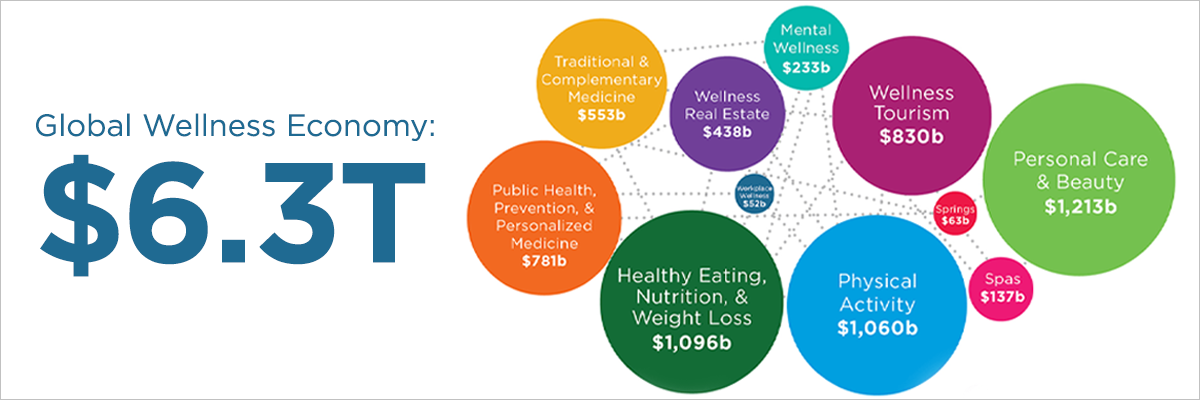
Global Wellness Economy Reaches $6.3 Trillion. Why Is It So Important to Measure It?
This month the Global Wellness Institute (GWI) released the latest edition of the Global Wellness Economy Monitor, which reveals that the wellness economy has reached a new peak of $6.3 trillion in 2023 and has been expanding by 6% annually since 2019. GWI’s research team has been studying wellness, both as a concept and as an industry, since 2008, and first defined and measured the global wellness economy back in 2014. Since then, the GWI has become the authoritative source for research on the industry. We are the only organization that produces market data and analysis for all 11 wellness sectors and for over 200 countries worldwide. In this edition of the GWI Brief, we explore the important impacts and drivers of GWI’s efforts to quantify the wellness industry over the last decade—and why measuring the market is so important.
Why measure the wellness economy?
On November 5, 2024, the Global Wellness Institute (GWI) released the latest edition of the Global Wellness Economy Monitor, which reveals that the wellness economy has reached a new peak of $6.3 trillion in 2023 and has been expanding by 6% annually since 2019. GWI’s research team has been studying wellness, both as a concept and as an industry, since 2008. We first defined and measured the size of the global wellness economy in 2014, when we published the first Global Spa & Wellness Economy Monitor.
Since then, the GWI has become the authoritative source for research on the global wellness economy. We are the only organization that produces market data and analysis for all 11 wellness sectors and for over 200 countries worldwide. We are recognized for the extensive expertise and rigorous methodologies we use to define and quantify large and emerging wellness sectors that have never been measured before. These include wellness tourism, wellness real estate, mental wellness, physical activity, thermal/mineral springs, spas, and many others.
Why is it important to measure the wellness economy?
As wellness becomes increasingly ubiquitous and embedded in our everyday lives, it is easy to forget that just a decade ago, there was no broadly agreed definition of what “wellness” meant, let alone an industry called “wellness.” Like many important industries that have emerged in the last 50 years—such as the IT industry, and the sustainability or “green” industry—the wellness industry is not measured in any standard industry datasets compiled by governments and multinational organizations.
The definition and quantification of wellness as a major global industry has had many significant effects:
- The wellness economy figures are an important resource for investors and businesses within the wellness industry and in adjacent spaces, in order to understand the size, future trajectory, and opportunities within this incredibly diverse sector that intersects with many other industries.
- By defining wellness and the industry sectors within the wellness economy, we help businesses and entrepreneurs recognize wellness as a cohesive industry, understand how different pieces are connected, and identify opportunities for collaboration and integration.
- Definitions are critical for the wellness economy and all its sectors, requiring discipline and a thorough understanding of wellness both as a concept and as an economic activity. If the definition is too narrow, it would limit imagination and innovation. If it is too broad, then everything could be considered “wellness,” rendering the measurement meaningless. If the definition is too vague or opaque, then the user would not know what the data are measuring. Our definitions require us to delineate a boundary around specific activities, services, and products in each wellness sector, in order to measure its market size. By articulating “new” wellness sectors that were not well understood before (e.g., wellness tourism, wellness real estate, mental wellness), we bring attention to these emerging sectors and help them attract investors and partners, and eventually take off.
- Measuring the wellness economy helps to raise the industry’s profile among consumers, entrepreneurs, investors, governments, and the research community. Having global data on the size and growth of the industry creates greater awareness of the consumer demand in the wellness space, stimulates new business ideas, and invites innovation. It also attracts more scientific and clinical research on ancient and emerging wellness modalities.
The wellness economy, as the GWI defines it, encompasses a diverse set of 11 industry sectors. We acknowledge that other researchers, economists, and industry analysts may have differing opinions on what constitutes the global wellness industry. The data presented in the Global Wellness Economy Monitor are based on the GWI research team’s 16 years of work in this space, as well as our collaborations with industry stakeholders worldwide, to understand the history and concept of wellness, how it is translated into economic activities, and how these activities can be defined and quantified.
Business and investors can benefit from many sources of data and measurements, and we welcome other industry and research organizations to join the effort. However wellness may be defined or measured, it is critical that any measurements of the global wellness industry are based on concise definitions, promote transparency on what is being measured and the methodologies employed, and adopt uniform estimation methodologies in each wellness sector and across different countries and regions.
For new insights and data on the global wellness economy, see GWI’s newly released 2024 Global Wellness Economy Monitor.
























































